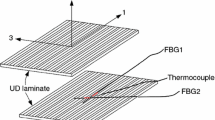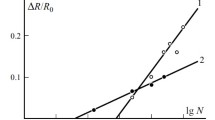Abstract
A study of residual stresses during the curing process of thermosetting resin composites is presented. A methodology is proposed for predicting the formation and the development of the manufacturing residual stresses, this approach is based on the determination of the resin yield stress. A self-consistent model is used to determine the cure-dependent effective mechanical properties, thermal expansion and chemical shrinkage coefficients of the composite material. This model allows considering for the composite material behaviour an anisotropic chemical shrinkage, which is not represented by a classical linear model. Finally, a one dimensional cure simulation and a modelling of residual stresses formation in composite plate are made by using a finite elements code. The effects of the cure-dependent material properties and of the resin yield stress on the residual stress formation are studied.













Similar content being viewed by others
References
Boghetti TA, Gillespie JW (1992) Process-induced stress and deformation in thick-section thermoset composite laminates. J Comp Mater 26:626–660
Griffin OH (1983) Three-dimensional curing stresses in symmetric cross-ply laminates with temperature-dependent properties. J Comp Mater 17:449–463
Hahn HT (1976) Residual stresses in polymer matrix composite laminates. J Comp Mater 10:266–277
Ruiz E, Trochu F (2005) Numerical analysis of cure temperature and internal residual stresses in thin and thick parts. Compos Part A-Appl S 36:806–826
Nelson RH, Cairns DS. Prediction of dimensional changes in composite laminates during cure. 34th International SAMPE Symposium and Exhibition
White SR, Kim YK (1998) Process-induced residual stresses analysis of AS4/3501-6 composite material. Mech Compos Mater St 5:153–186
Abou-Msallem Y, Boyard N, Jacquemin F, Poitou A, Delaunay D, Chatel S (2008) Identification of thermal and rheological properties of an aeronautic epoxy resin-simulation of residual stresses. Int J Mater Form Springer (Esaform 2008): 579–582
Bailleul JL, Delaunay D, Jarny Y (1996) Determination of temperature variable properties of composite materials: methodology and experimental results. J Reinf Plast Comp 15:480–496
Kröner E (1958) Berechnung der elastischen Konstanten des Vielkristalls aus des Konstanten des Einkristalls. Zeitschrift für Physik 15:504–518
Eshelby JD (1957) The determination of the elastic field of an ellipsoidal inclusion and related problems. Proc Roy Soc London A241:376–396
Hutchinson JW (1970) Elastic-plastic behaviour of polycrystalline metals and composites. Proc Roy Soc London 319:247–272
Jacquemin F, Fréour S, Guillén V (2004) A hygro-elastic self-consistent model for fiber-reinforced composites. J Reinf Plast Compos 5:485–502
Abou-Msallem Y (2008) Thermal and mechanical characterisation of an aeronautic composite material during the manufacturing process-contribution to the estimation of the residual stresses, PHD Thesis Ecole Centrale Nantes France
Abou-Msallem Y, Jacquemin F, Boyard N, Poitou A, Delaunay D, Chatel S (2008) Characterisation of an aeronautic epoxy resin during the manufacturing process-simulation of residual stresses in epoxy matrix composites. FPCM9 Montréal (Québec), Canada
Winter H (1987) Can the gel point of cross linking polymer be detected by the G′–G″ crossover. Polym Eng Sci 27(22):1698–1702
Author information
Authors and Affiliations
Corresponding author
Rights and permissions
About this article
Cite this article
Msallem, Y.A., Jacquemin, F. & Poitou, A. Residual stresses formation during the manufacturing process of epoxy matrix composites: resin yield stress and anisotropic chemical shrinkage. Int J Mater Form 3 (Suppl 2), 1363–1372 (2010). https://doi.org/10.1007/s12289-010-0688-1
Received:
Accepted:
Published:
Issue Date:
DOI: https://doi.org/10.1007/s12289-010-0688-1




